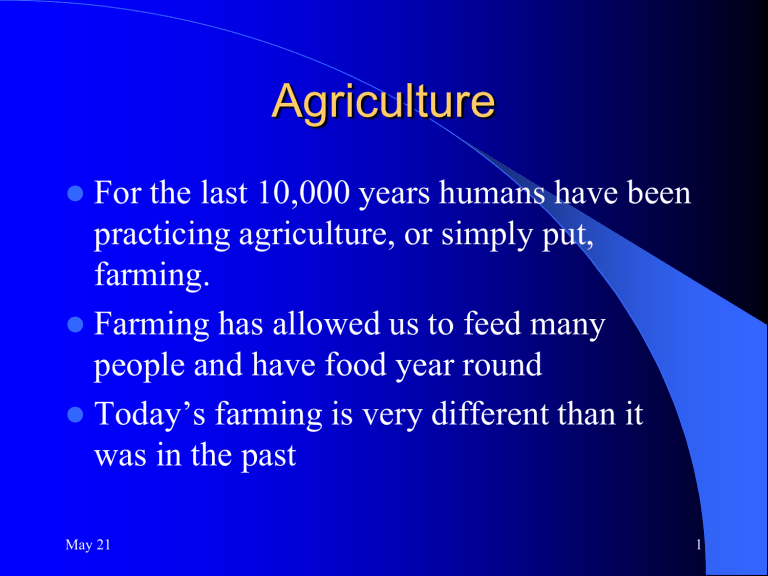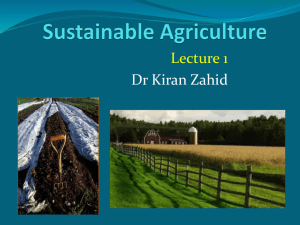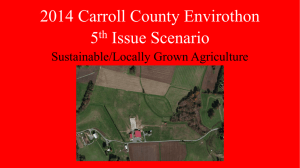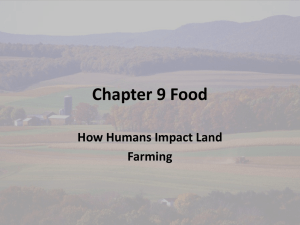
Agriculture For the last 10,000 years humans have been practicing agriculture, or simply put, farming. Farming has allowed us to feed many people and have food year round Today’s farming is very different than it was in the past May 21 1 Conventional/Industrial Agriculture Industrial agriculture is how most of our food is made. It is large scale designed to make the most amount of food with the smallest amount of space May 21 Toward a Sustainable Agriculture 2 What you think it looks like.. May 21 Toward a Sustainable Agriculture 3 What it really looks like… May 21 Toward a Sustainable Agriculture 4 What you think it looks like… May 21 Toward a Sustainable Agriculture 5 What it really looks like… May 21 Toward a Sustainable Agriculture 6 Monocultures A monoculture is an area of land that only grows a large amount of one crop. This makes it very easy for pests to destroy the crops. As a result, pesticides are used. May 21 Toward a Sustainable Agriculture 7 Pesticides Pesticides damage soil and can run off into the surrounding area May 21 Toward a Sustainable Agriculture 8 Pesticides If a small amount of the pests survives and are resistant to the pesticide, then they will repopulate and a stronger, more toxic pesticide must be used. May 21 Toward a Sustainable Agriculture 9 Fertilizers Since the soil gets degraded quickly, fertilizers must be added to the soil. Fertilizer runoff causes “eutrophication” which means “too much of a good thing” because the added nutrients cause algae to flourish and choke out aquatic ecosystems May 21 Toward a Sustainable Agriculture 10 Where are we? What are the Strengths and Weaknesses of our current agricultural system? May 21 Toward a Sustainable Agriculture 11 Successes abundant food supply in the developed world fresh fruits and vegetables available year-round cheap food luxury foods such as coffee, tea, chocolate, and spices easily available around the world effective food preservation technologies (refrigeration, freezing, canning, packaging) convenience foods mechanization produces high labor efficiency availability of agricultural inputs for quick solutions to production problems May 21 Toward a Sustainable Agriculture 12 Problems continuing soil loss food safety concerns (mad cow disease, food poisoning outbreaks, antibiotic resistance, toxins and pesticides) water pollution, air pollution (& odors), habitat loss, water depletion continuing hunger – and rise of obesity failing farms, economic uncertainty and stress declining communities farm accidents, chronic diseases linked to agricultural chemicals reliance on fossil fuels, global warming farmland loss to development, ugly countryside difficulty of starting in farming May 21 Toward a Sustainable Agriculture 13 What is Sustainable Agriculture? “…a journey, not a destination” Iowa Farmer May 21 Toward a Sustainable Agriculture 14 Sustainable Agriculture “…an integrated system of plant and animal production practices…that will satisfy human food and fiber needs enhance environmental quality make the most efficient use of nonrenewable resources sustain economic viability enhance quality of life.” 1990 Farm Bill May 21 Toward a Sustainable Agriculture 15 The three-legged stool of sustainability May 21 Toward a Sustainable Agriculture 16 Economically sustainable Provides a secure living for farm families Provides a secure living to other workers in the food system Provides access to good food for all May 21 Toward a Sustainable Agriculture 17 Environmentally Sound Preserves the quality of soil, water, and air May 21 Toward a Sustainable Agriculture 18 Environmentally Sound Cooperates with and is modeled on natural systems May 21 Toward a Sustainable Agriculture 19 Socially sustainable Good for families Supports communities Fair to all involved May 21 Toward a Sustainable Agriculture 20 How to farm sustainably Farmers plant many different crops near each other so that a pest can’t destroy an entire crop Waste products are composted and used to replace nutrients in the soil. Crops are rotated to preserve the nutrients in the soil. May 21 Toward a Sustainable Agriculture 21 How to farm sustainably Animals are treated fairly and given the freedom to move. Animals are not given unnecessary antibiotics. Animals are fed properly May 21 Toward a Sustainable Agriculture 22 Conclusion Agriculture has accomplished much There are still many problems to solve, both old and new Sustainable agriculture is about trying to solve these problems – without creating new ones. May 21 Toward a Sustainable Agriculture 23 How much is 2 billion bushels? Iowa’s annual corn harvest is usually around 2 billion bushels. If you loaded semi trucks with 2 billion bushels and lined them up bumper to bumper, how far would they stretch? According to the Iowa Department of Transportation, a large semi holds around 910 bushels, and 879 large semis lined up bumper to bumper would stretch around 11.5 miles May 21 Toward a Sustainable Agriculture 24 Answer: The line of trucks would stretch 29,206 miles, or more than the circumference of the earth (which is a little under 25,000 miles). Luckily, most grain is transported much more efficiently in railroad cars and on barges. May 21 Toward a Sustainable Agriculture 25




